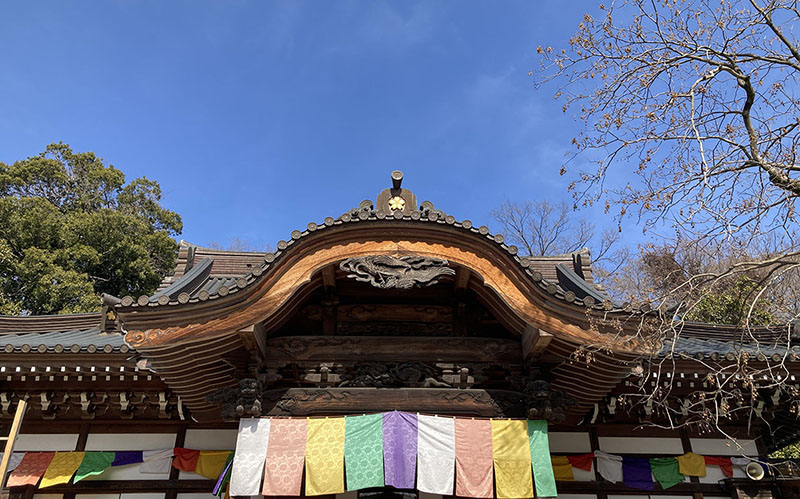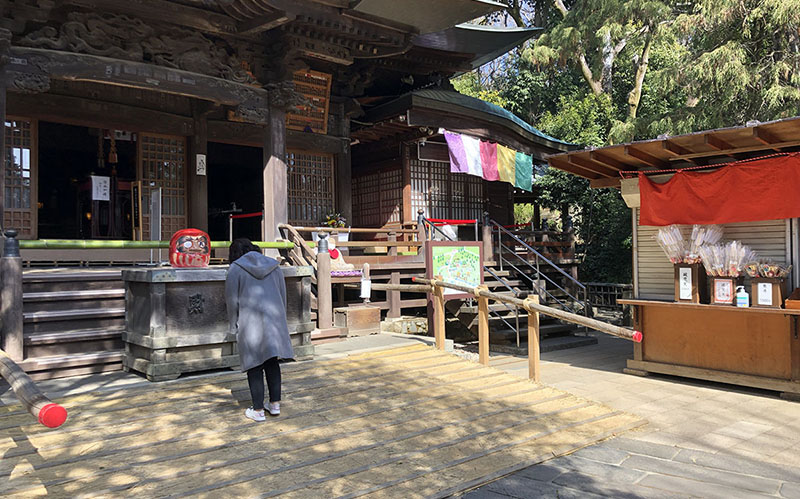Located in Chofu, Tokyo, Jindaiji has a history of about 1,300 years and is the second oldest temple in Tokyo. Located a little far from the city center, it is blessed with lush greenery and water, making it a perfect place for a quiet stroll. Jindaiji also enshrines ‘Jinja Daioh’, the god of water.
In addition to being known for the ‘Jindaiji Daruma Market’, one of the three major Daruma doll markets in Japan, the surrounding area has been famous for soba (buckwheat) noodles since the Edo period, and about 20 stores line the streets near the temple. If you visit the Daruma Market, make sure to try soba noodles too.

History of Jindaiji temple
Jindaiji Temple is the second oldest temple in Tokyo with a history of approximately 1,300 years, and is home to the oldest Buddhist statue of Shakyamuni Buddha in eastern Japan and the only temple in Tokyo with a national treasure, the Shakyamuni Buddha. The temple was founded in 733 as a temple of the Hosso sect of Buddhism during the Nara period (733-784). It is said that the temple was founded when Mannojo Shonin, a priest who returned from Tang Dynasty China, enshrined Jinja Daio, a god of protection against evil who had brought his parents together, in a place with abundant water.
During the Heian period (794-1185), the temple was converted to the Tendai sect when the monk Eryo Kasho of Mt. Hieizan, in order to pacify the Musashi region in the eastern part of Japan, made Jindaiji an esoteric Buddhism center. The temple suffered fires in 1646 and 1864 during the Edo period, and the current main hall was rebuilt in the Taisho period (1912-1926).


Sights to see of Jindaiji Temple
Kitaro Chaya
To get to Jindaiji, take a 20-minute bus bound for Jindaiji from Mitaka Station, which is famous for the Mitaka no mori Ghibli Museum, where the creator of Studio Ghibli, Miyazaki Hayao, is the director. After getting off at the Jindaiji bus stop, you will find the tourist information center nearby, at the entrance of the approach. After walking for about two minutes, you will see the large sanmon gate of Jindaiji.
As you walk, you will see the ‘Kitaro Chaya of Jindaiji, Chofu’. Jindaiji is the second hometown of Mizuki Shigeru, the creator of the anime ‘GeGeGe no Kitaro.’ Kitaro Chaya is a café, shop, and gallery, recreating the world of Mizuki Shigeru, whose theme was to live in harmony with nature. Even if you are not familiar with his works, this is a great spot to stop by on your way home.


Spring Water and Soba Noodles
Jindaiji is said to have been founded in 733 during the Nara period as a temple of the Hoso sect. It was converted to the Tendai sect in the Heian period. The temple was destroyed by fire twice during Edo period, in 1646 and 1864. The current main hall was rebuilt during the Taisho period.
Jindaiji has always been an area with many springs, and even today there are multiple sources of spring water within the temple grounds. One of the spring-fed waterfalls , ‘Waterfall of Fudo’, has been selected as one of the 57 best springs in Tokyo. In the old days, people used to meditate under this waterfall (takigyo).
Jindaiji soba is the result of this abundant spring water. In the Edo period, the land around Jindaiji was not suitable for rice production, so peasants made buckwheat and delivered buckwheat flour to the temple instead of rice. It is said that Jindaiji soba began when the temple made and served soba to guests.





Precincts
Jindaiji is known for its spacious precinct. Many of the halls are surrounded by wooded areas, and there is also the Jindai Botanical Gardens where you can feel the nature of each of the four seasons. You can enjoy a leisurely stroll while admiring cherry blossoms and fresh greenery in spring, fireflies in summer, and Japanese autumn leaves in autumn.
If you want to get rid of bad luck, pay a visit to Gansan Taishido, and if you want to live a long life, pay a visit to Enmei Kannon.





Hakuhoh Buddha (National Treasure)
The bronze statue of Shakyamuni Buddha (Hakuhoh-butsu), a national treasure, was created in the late Asuka period (late 7th to early 8th century), the so-called ‘Hakuhoh’ period. It was discovered in 1909 under the platform of the Gansan Taishido. Along with the perfect replicas of ‘Yumechigai Kannon statue’ of Horyuji and ‘Koyakushi statue’ of Shin’yakushiji, the statue can be viewed in the Shakado, albeit through glass.



Daruma Doll Market
Daruma dolls are popular as good luck charms because they get up quickly after falling down. Every year on March 3rd and 4th, Jindaiji holds the Jindaiji Daruma Market, one of the three largest Daruma markets in Japan.
On that day, about 300 Daruma doll stores line the temple grounds, and the rows of countless Daruma dolls are quite a sight.


The Nanja Monja Tree
There are many trees in Jindaiji, and from late April to early May, you may be able to see the blossoming of the ‘nanja monja tree’. The tree is known as ‘snow flower’ in English. The way the pure white flowers bloom and the green tree gradually turn white, it looks as if snow is covering the tree.
In Japan, it is said that the tree came to be called ‘nanja monja tree’ because people used to say, “Areha Nanja (what’s that?),” for they didn’t know the name of the tree.


Access to Jindaiji Temple
5-15-1 Jindaiji-Motomachi, Chofu City, Tokyo
TEL : +81-42-486-5511
Parking around Jindaiji Temple
Jindaiji Temple Official Website
official site:https://www.jindaiji.or.jp/
